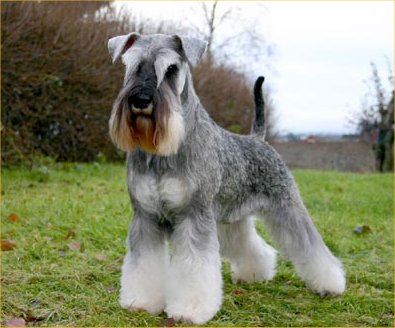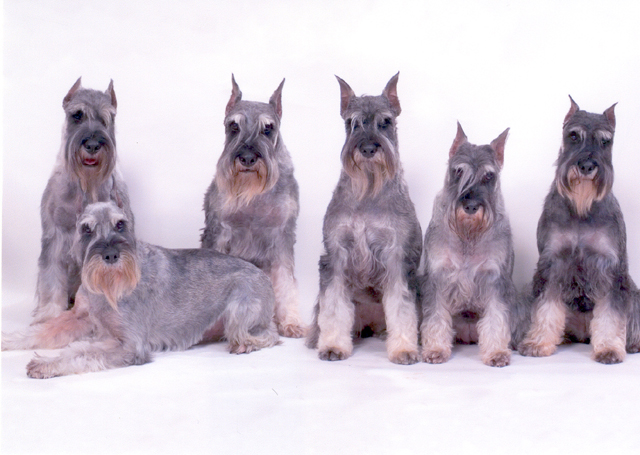

Standard Schnauzers
The Standard
Schnauzer is the original
breed of the three breeds
of
Schnauzer, and despite its
wiry coat and general appearance, is not related to the British terriers.
Rather, its origins are in old herding and guard breeds of
Europe. The AKC classifies
the Standard Schnauzer as
Working Dog; however, this
versatile breed is a robust, squarely built, medium-sized
dog with aristocratic
bearing. It was a popular subject of painters
Sir Joshua Reynolds,
Albrecht Dürer and
Rembrandt.
Standard Schnauzers are typically Pepper & Salt or Black in color, and are known for exhibiting many of the "ideal" traits of any breed. These include high intelligence, agility, alertness, reliability, strong with high endurance, and loving companion. Standard Schnauzers are one of the oldest breeds with over 500 years of history. This breed of dog has been very popular in Europe, specifically Germany where it originated. The breed was first exhibited at a show in Hanover in 1879. They are majestic and regal in the show ring, and have taken top honors in many shows including the prestigious "Best in Show at Westminster Kennel Club" in 1997.

Schnauzers are originally a German breed, descended
during the Middle Ages from herding, ratting and guardian breeds. They may be
most closely related to German Pinschers, and the
spitz-type breeds. Dogs
very similar to today's schnauzers existed in the Middle Ages. They were
portrayed in
paintings,
statues and tapestries,
including by artists
Rembrandt,
Dürer and
Reynolds. Initially a dog
of the peasant farmer, in the 19th century this breed captured the interest of
the German dog fancier and they began to be bred to a standard.
The Schnauzer breed takes its name from one of its
kind, a show dog winner by that name, "Schnauzer", at the 1879 Hanover Show in
Germany. The word Schnauzer
(from the German word for 'snout') appeared for the first time in 1842 when used
as a synonym for the Wire-haired Pinscher
(the name under which the breed first competed at dog shows). The Standard
Schnauzer is the original Schnauzer from which the Miniature and Giant breeds
were developed in the late 19th century. They have been shown from the 1870s
onwards and first appeared in the
United States about 1900.
The name "schnauz bart" means "conspicuous moustache or beard". The Standard
Schnauzer has been used throughout modern history in various roles. The
Red Cross used the dogs for
guard duty during World War I. Both German and American
police departments put the
dogs to work as well. Several Standards have been used in the USA for drug and
bomb detection, and also as search-and-rescue dogs.
Appearance
Standard Schnauzers are always pepper and salt or less commonly black in color, with a stiff and wiry fur coat on the body similar to that of other wirehaired breeds such as many breeds of terrier. Their hair will perpetually grow in length without properly shedding. Twice a year, when most other breeds of dog are shedding their coat, a Schnauzer’s coat will become dull and relatively easy to pull out and is said to have ‘blown’. At this point the coat can be stripped or pulled out by hand and a new wire coat will re-grow in its place. Stripping is not painful for the dog and can be performed at any stage of hair growth although it is easier to do when the coat is ‘blown’. Alternatively, the coat can be regularly clipped with shears. Clipping as opposed to stripping results in a loss of the wiry texture and some of the fullness of the coat. Dogs with clipped fur no longer ‘blow’ their coat but the coat loses its wiry texture and becomes soft.

The fur of clipped dogs tends to be
more prone to tangling and knots, particularly when long, and is duller in color
than that of stripped coats. In the case of the salt and pepper Schnauzers, the
characteristic banded color of the hair is completely lost when maintained
through clipping; each shaft of hair becomes entirely grey rather than being
banded with multiple shades of grey, white, and black. Regardless of whether the
body of the coat is stripped or clipped the 'furnishings' or longer hair on the
legs and face must be scissored or clipped regularly and require regular
brushing to remain free of potentially painful mats. Whether a Schnauzer is
stripped or clipped, his coat requires a great deal of grooming. In most cases
this means regular brushing on the part of the owner and regular, often
expensive, trips to a grooming salon.
Clipping is most common in the US as it can be difficult to
locate a professional willing to hand strip as the process is quite labor
intensive. In Europe it is very uncommon to see a wirecoated dog which is
clipped. It may not be possible to hand strip a poor quality coat, i.e. one that
is soft in texture, but soft coats, while relatively common in pet quality
Miniature Schnauzers, is not a widespread problem in Standards.
Inside the US and Canada, ears and tail and dewclaws are
typically
docked as a puppy. Vets or
experienced breeders will cut tails and dewclaws at a few days of age, while ear
cropping is usually performed at about 10 weeks. Outside of North America, most
Standard Schnauzers retain both their natural ears and tail as docking is now
prohibited by law in Europe. Like the
Miniature Schnauzer and
Giant Schnauzer, these
breeds are most noted by their long beard and eyebrows giving them a regal and
wise appearance. It is important to note, the
Miniature Schnauzer and
Giant Schnauzer were bred
from the Standard Schnauzer using additions of smaller and larger breeds
respectively to change the size and, to some degree, the character of the dog.
Thus the Standard Schnauzer is the original and oldest
breed of Schnauzer.
Standard Schnauzer males ideally are 18-20 inches high at the
shoulders and weigh 35-50 pounds. The females ideally are 17-19 inches high at
the shoulders and generally weigh 30-45 pounds.
Temperament
The Standard Schnauzer Club of America states that "The Standard Schnauzer is a squarely built, very energetic, medium-sized dog with a stiff, wiry coat. It is a robust and sturdy working dog, yet small enough in stature not to be overwhelming." Standard schnauzers make loyal family dogs with guardian instincts. Most will protect their home from uninvited visitors with a deep and robust bark. The breed is also known to be intelligent and easy to train. They adapt well to any climatic conditions, including cold winters. In general, they are good with kids and adults alike. It is, however, important to socialize from the start. If properly trained, they can be very patient and tolerant. Like other working dogs, standard schnauzers require a fairly strong-willed owner that can be consistent and firm with training and commands. They are ranked 18th in Stanley Coren's The Intelligence of Dogs, being of excellent working/obedience intelligence.

According to the SSDA, “The Standard
Schnauzer is considered a high-energy
dog. They need ample
exercise not only for physical well-being, but also for emotional well-being.
The minimum amount an adult
dog should get is the
equivalent of a one long walk a day. This walk should be brisk enough to keep
the
dog at a steady trotting
pace in order to keep the
dog in prime physical
condition. The Standard Schnauzer
puppy is constantly
exploring, learning and testing his limits. As adults, they are always ready for
a walk in the woods, a ride in the car, a training session or any other activity
that allows them to be with their owner. This is a breed that knows how to be on
the alert, even when relaxing by the feet of their owner. Standard Schnauzers
are extremely versatile, excelling at
dog sports such as
agility,
obedience,
tracking,
Disc dog,
Flyball and even
herding.
Intelligence
Standard Schnauzers are among the most intelligent dogs in the
world. In fact they are often called the dog with a human brain. Standard
Schnauzers are very quick learners but are slow to mature; which means though
smart, they may be quite playful until about two years old. But after they
mature, however, they are a shining beakon of intelligence. Intelligence also
means busy. Owners must be prepared to mentally stimulate their Schnauzer;
whilst training owners must move between activities quickly. A bored Schnauzer
is a destructive Schnauzer.
The Schnauzer's intelligence shows when they are stimulated.
Their intelligence and bravery is what has lead the Standard Schnauzer to be
used as police dogs in Europe. They are also excellent working dogs as they
shine in any task given to them.
The Standard Schnauzer's appearance is said to match their
extreme intelligence and aristocratic bearing; the Schnauzer is considered to
look wise and somewhat "Professor like" (see for picture).
Health
Overall, the Standard Schnauzer is a
very healthy
breed. The survey included
some 1450 dogs, or aproxamately 15% of the Standard Schnauzer population alive
sometime during the 2007-8 period. The preliminary report of the 2007-8 health
survey done by the Standard Schnauzer Club of America revealed that roughly only
1% of dogs surveyed had serious health issues. The final report is
expected to be published around Sept. 2009, but the preliminary analysis is as
follows:
·
Over half of all Standards Schnauzers live
to over 12.9 years;
·
Only few serious diseases were noted;
·
Potentially serious conditions affect only
a few (less than 1%) dogs;
·
Some diseases/conditions will need a
watchful eye
Two major hereditary problems of concern within the breed are: hip dysplasia and hereditary eye disease. Both problems can be tested for and identified in breeding stock before they pass the trait onto the next generation, so the Standard Schnauzer Club of America recommends that every kennel test their breeding stock for hip and eye problems before breeding and to use only health animals for breeding. However, because the SSCA is the parent club for the Standard Schnauzer the AKC prohibits them from mandating any type of health screening. Therefore it is entirely up to breeders whether they choose to health test their animals and whether they choose use animals for breeding despite knowing they have tested positive for carrying a genetic disease.

The
Orthopedic Foundation for Animals
found at
www.offa.org keeps a record
of purebred animals that have passed an x-ray screening for hips problems. Dogs
must be a minimum of two years old to be OFA tested and tests are only valid for
one year; breeding stock must be x-rayed and re-certified each year. The cost of
OFA testing is relatively high (about 150-200 USD per dog per year) and born
directly by breeders, but OFA testing is not required for AKC registration of
breeding stock or their offspring so the benefits of a good OFA test scores are
more indirect and long range for individual breeders while a poor results
represent a direct negative impact. Therefore, many breeders choose to skip OFA
testing altogether or do not renew OFA certification for all of their breeding
stock each year once a dog is granted one good score. Responsible buyers looking
to buy from responsible breeders should look for breeders who test all their
breeding stock annually or at least choose puppies from a litter where both
parents have current OFA test certificates and scores of "excellent", "good" or
"fair". All dogs with current OFA test results are listed online at the OFA's
official website: www.offa.org.
The
Canine Eye Registration Foundation
is a registry for purebred breeding stock who have been certified free of any
hereditary eye disease: results for this test can also be found at the OFA
website. Dogs must be examined by an approved veterinarian who checks for the
presence of heritable eye diseases. Testing is less inexpensive (about 20-40
USD) than OFA examinations but, like OFA testing, must be done annually to
remain valid.
The SSCA also encourages all potential buyers to ask their
breeder for up to date OFA and CERF certifications of the parent dogs before
buying a puppy.
Click here to go to the top of the page
